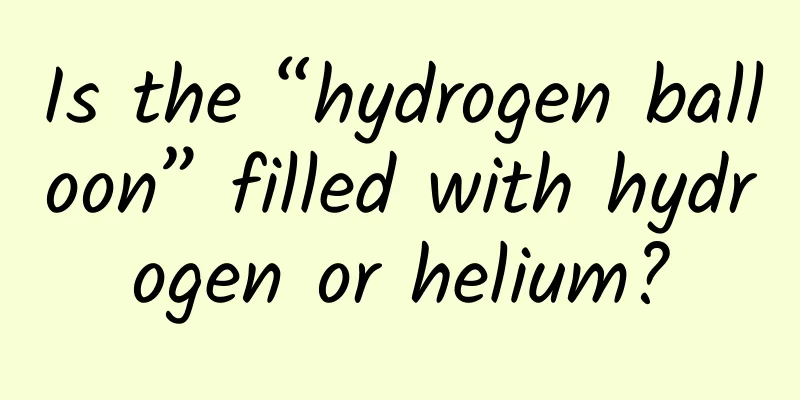Is the “hydrogen balloon” filled with hydrogen or helium?

|
When I think back to my childhood, I can’t help but think of balloons. In the scenes I remember, whether in the park or on the street, there would always be vendors selling balloons, with a cloud of cartoon balloons on their heads, shouting slowly. From the classic Mickey Mouse and Calabash Brothers, to Blue Cat and Naughty, to Pleasant Goat and Peppa Pig, the people selling balloons always seem to know what children like best. Image source: Photographed by the author Everyone gave these childhood "little friends" a unified name - "hydrogen balloons" . Many careful friends may wonder why hydrogen balloons can float in the air, but the balloons we blow with our mouths or inflate with an air pump cannot float? Want to know the answer? Today, we will take you through the history of hydrogen balloons . Part 1 The past and present of hydrogen balloons Children's demands are often simple: "the ability to float above the head" is their highest requirement for a qualified hydrogen balloon. However, hydrogen balloons in history are not only able to float above the head, they also have the function of carrying people and goods . The world's first hydrogen balloon was born in 1780. It was made by French chemist Braque by filling hydrogen into a pig's bladder. The world's first hydrogen balloon flight without any passengers or cargo was designed and implemented by Professor Jacques Charles in August 1783. On December 1, 1783, Jacques Charles and Nicolas-Louis Robert flew their second hydrogen balloon for a manned flight. As time goes by, the types and uses of hydrogen balloons have continued to expand. There are commercial hydrogen balloons used for floating advertising banners, hydrogen balloons for high-altitude meteorological detection, and small latex hydrogen balloons for festivals and toys. Image source: veer gallery However, no matter what the hydrogen balloon is used for, its filling gas is actually only hydrogen and helium. Yes, although it is called a hydrogen balloon, helium can occasionally be used as the filling gas. The reason for choosing these two gases has to do with the floating principle of hydrogen balloons and the physical and chemical properties of the gases. Part 2 The floating principle of hydrogen balloons According to Archimedes' law (also known as the law of buoyancy), an object immersed in a liquid or gas will be subject to an upward buoyant force equal to the weight of the liquid or gas displaced by the object . Specifically, when the balloon is filled with a gas of lower density, its volume expands and displaces the air, and the weight of the displaced air is the buoyancy of the balloon (the schematic diagram is shown below). Hydrogen balloon floating principle diagram (created by the author) Since low-density air is lighter than air of the same volume, even with the weight of the balloon's outer skin, the overall gravity on the balloon is lighter. As a result, the buoyancy is greater than the gravity, and the balloon floats up, and then flies higher and higher. So what kind of gas can make a balloon float? Let's first look at the standard density of common gases (unit: kg/cubic meter) The table above lists some common gases with a density lower than that of air (1.29 kg/m3), among which hydrogen, helium, ammonia and methane are obviously lighter than air. In fact, theoretically speaking, as long as the above-mentioned gases are filled into the balloon, the balloon can float easily. However, some gases are not suitable as filling gases due to their own characteristics. Among them, ammonia has a strong irritating odor and is easily adsorbed on the skin mucous membranes and conjunctiva, causing irritation and inflammation. As the source of the odor in toilet sewers, filling balloons with ammonia is really not a pleasing act. Methane is the main component of domestic natural gas, which is as flammable and explosive as hydrogen, but much heavier than hydrogen. Therefore, the filling gas of the "hydrogen balloons" that can float on the market is often hydrogen and helium . Image source: veer Hydrogen and helium are the two most abundant elements in the universe, but their content in the Earth's atmosphere is extremely small. According to statistics, due to atmospheric escape, about 95,000 tons of hydrogen and about 1,600 tons of helium escape into the universe every year on our Earth. Fortunately, since the earth is rich in water and various hydrogen-containing compounds, hydrogen is not difficult to obtain. However, as an inert gas, helium is difficult to form compounds with other elements, so the ways to obtain helium are limited. The entire lithosphere produces an estimated 3,000 tons of helium each year, which is often captured and enriched by natural gas, and humans can separate and purify helium by mining natural gas. Helium is a non-renewable resource, and natural helium is currently the only source of industrial helium production, which has led to a global shortage of helium resources around the world. As one of the rare strategic materials used in military, scientific research, medical, industrial and other fields, the price of helium is far higher than that of hydrogen. Due to cost limitations, even though helium is safer, most of the filling gas in "hydrogen balloons" on the market is still real hydrogen . Part 3 Hydrogen is dangerous, please be careful when playing Behind these beautiful balloons filled with hydrogen, there are actually huge safety and environmental risks. In recent years, cases of injuries and deaths caused by hydrogen balloon explosions have been reported frequently in the news. News reports showed that in 2014, during the opening ceremony of a shopping mall in a certain place, an advertising hydrogen balloon fell off and floated to another area hundreds of kilometers away. After being discovered by a child, the balloon was taken home. A few days later, the balloon exploded, causing the collapse of a house, resulting in a tragedy in which two people were killed and three were injured. Hydrogen is flammable and explosive, and its explosion limit in the air is between 4% and 75%. This means that in the air, as long as the hydrogen content reaches this range, even if there is only a little open flame, an explosion will occur. What is even more worrying is that in real life scenarios, the hydrogen in hydrogen balloons is extremely easy to leak, and there is no need for open flames. Just the electric sparks caused by static electricity generated by rubber friction are enough to ignite or explode the hydrogen balloon. Moreover, the hydrogen filled in many hydrogen balloons is not pure enough, and a small amount of air may be mixed in during the filling process, which makes the already dangerous situation even more dangerous. In fact, as early as July 2006, the National Meteorological Administration and other departments jointly issued the "Notice on Further Strengthening the Safety Management of Balloon Releases", advocating the use of inert gases instead of flammable and explosive gases such as hydrogen as fillings for balloon releases to reduce safety hazards . In general, helium, as an inert gas, is extremely stable and will not become a time bomb around you like hydrogen. And its density is also low, enough to provide sufficient lift for hydrogen balloons. So for everyone's safety, when purchasing hydrogen balloons, you must give priority to hydrogen balloons filled with helium. At the same time, you must also tell the children around you about the dangers and try to stay away from hydrogen balloons. References: [1]Austerfield, PJ From hot air to hydrogen: filling and flying the early gas balloons. [J]Endeavor,1990,14(4):194–200. [2] Zartman, RE; Wasserburg, GJ; Reynolds, JH Helium Argon and Carbon in Natural Gases" (J). Journal of Geophysical Research. 1961, 66(1): 277–306. [3] Liu Jianxiang. On the safe release of hydrogen balloons[J]. Environmental Protection, 2016, 3. Produced by: Science Popularization China Author: XY (Dalian Institute of Chemical Physics, Chinese Academy of Sciences) The article only represents the author's views and does not represent the position of China Science Expo This article was first published in China Science Expo (kepubolan) Please indicate the source of the public account when reprinting Please indicate the source of the reprint. Reprinting without authorization is prohibited. For reprint authorization, cooperation, and submission matters, please contact [email protected] |
<<: These inconspicuous little particles at home are actually insect eggs? !
>>: Walruses don't eat with their teeth, they eat with their butts
Recommend
Collection | 7 secrets to using "Toutiao" to attract traffic. It will be too late if you don't do it now!
There are many self-media platforms today, and al...
Data Brother Qianchuan practical online advanced course video
Data Brother Qianchuan practical online advanced ...
People with myopia, stay away from sweets! Even if your eyesight is poor, you can't pretend you don't see it!
I remember seeing a hot search, "People with...
Three ways to increase users in the second half of Internet finance!
The development of Internet finance has entered t...
Rural car purchase subsidy policy in 2022: How to apply? How much? Attached are car models for rural areas!
In the process of rapid social and economic develo...
Useful information | Data analysis thinking is essential for marketing promotion!
In this Internet age, we set up most of our marke...
Digital RMB is getting closer, what are its advantages? Will "scanning" become a thing of the past?
With the popularity of smart phones, it has becom...
Three ways to get traffic
Look at the picture I posted below. This is a pic...
Why is there weightlessness in the space station? Does weightlessness mean “losing weight”?
The astronauts' space lectures let us see man...
Double Eleven advertising farce: a bite and a bite back
As Double Eleven approaches, major e-commerce com...
What is the difference between "sand" and "grit"? You should know some scientific knowledge!
1. What is the difference between "sand"...
Trump's unexpected election as US president reveals his shady career history
The US presidential election finally came to an e...
The third episode of the Aiti tribe consultation: Analysis of Python's advantages in big data processing
【51CTO.com original article】 Activity description...
Exclusive interview with Yan Zhitao, Vice President of R&D at TalkingData: Uncovering the secrets of big data
[[123691]] In the era of big data, the value of d...









